
Aloe is a genus containing over 650 species of flowering succulent plants. The most widely known species is Aloe vera, or "true aloe". It is called this because it is cultivated as the standard source for assorted pharmaceutical purposes. Other species, such as Aloe ferox, are also cultivated or harvested from the wild for similar applications.

The Polygonaceae are a family of flowering plants known informally as the knotweed family or smartweed—buckwheat family in the United States. The name is based on the genus Polygonum, and was first used by Antoine Laurent de Jussieu in 1789 in his book, Genera Plantarum. The name may refer to the many swollen nodes the stems of some species have, being derived from Greek [poly meaning 'many' and gony meaning 'knee' or 'joint']. Alternatively, it may have a different origin, meaning 'many seeds'.

Dracocephalum is a genus of about 60 to 70 species of flowering plants in the family Lamiaceae, native to temperate regions of the Northern Hemisphere. These flowers, collectively called dragonhead, are annual or perennial herbaceous plants or subshrubs, growing to 15 to 90 centimeters tall.

Ribes is a genus of about 200 known species of flowering plants, most of them native to the temperate regions of the Northern Hemisphere. The various species are known as currants or gooseberries, and some are cultivated for their edible fruit or as ornamental plants. Ribes is the only genus in the family Grossulariaceae.

Linaria is a genus of almost 200 species of flowering plants, one of several related groups commonly called toadflax. They are annuals and herbaceous perennials, and the largest genus in the Antirrhineae tribe of the plantain family Plantaginaceae.

The genus Pulsatilla contains about 40 species of herbaceous perennial plants native to meadows and prairies of North America, Europe, and Asia. Derived from the Hebrew word for Passover, "pasakh", the common name pasque flower refers to the Easter (Passover) flowering period, in the spring. Common names include pasque flower, wind flower, prairie crocus, Easter flower, and meadow anemone. Several species are valued ornamentals because of their finely-dissected leaves, solitary bell-shaped flowers, and plumed seed heads. The showy part of the flower consists of sepals, not petals.
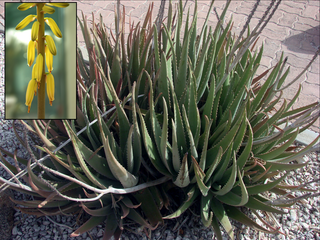
Aloe vera is a succulent plant species of the genus Aloe. It is widely distributed, and is considered an invasive species in many world regions.

Cynoglossum is a genus of small-flowered plants in the family Boraginaceae.

Myrrhis odorata, with common names cicely, sweet cicely, myrrh, garden myrrh, and sweet chervil, is a herbaceous perennial plant belonging to the celery family Apiaceae. It is the only species in the genus Myrrhis.

Acacia, commonly known as the wattles or acacias, is a genus of about 1084 species of shrubs and trees in the subfamily Mimosoideae of the pea family Fabaceae. Initially, it comprised a group of plant species native to Africa, South America and Australasia, but is now reserved for species mainly from Australia, with others from New Guinea, Southeast Asia and the Indian Ocean. The genus name is Neo-Latin, borrowed from the Greek ἀκακία, a term used by Dioscorides for a preparation extracted from the leaves and fruit pods of Vachellia nilotica, the original type of the genus. In his Pinax (1623), Gaspard Bauhin mentioned the Greek ἀκακία from Dioscorides as the origin of the Latin name.
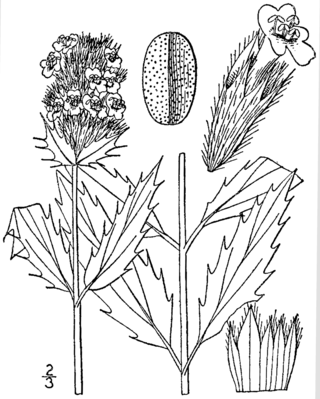
Dracocephalum parviflorum, known as dragonhead mint or American dragonhead, is a wild North American mint growing across much of the United States, as well as much of Canada and Alaska. It grows as either an annual or biennial, producing clusters of small pink to violet flowers in whorls at the ends of many branching stems. The seeds are small, dark, and high in oil content, about 20%.
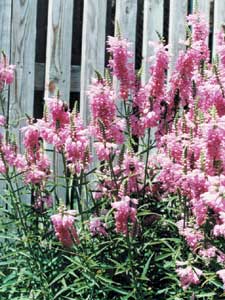
Physostegia, the lionshearts or false dragonheads, is a genus of flowering plants in the family Lamiaceae, native to North America. They are erect rhizomatous herbaceous perennials inhabiting damp, sunny places. They grow up to 2 m (7 ft) tall with purple or pink tubular flowers in racemes in summer.

Physostegia virginiana, the obedient plant, obedience or false dragonhead, is a species of flowering plant in the mint family, Lamiaceae. It is native to North America, where it is distributed from eastern Canada to northern Mexico. Physostegia are known commonly as obedient plants because a flower pushed to one side will often stay in that position. The name “false dragonhead” refers to the dragonheads of the related Dracocephalum, a genus to which the plant once belonged.

The facing heaven pepper is a type of cone pepper, a group of cone-shaped, medium-hot chili peppers within the species Capsicum annuum. The species is native to Central America.

Tournefortia, commonly known as soldierbush, is a genus of flowering plants in the borage family, Boraginaceae.

Dracocephalum moldavica, the Moldavian dragonhead, is an annual herbaceous plant. The first formal botanical description of D. moldavica was by Linnaeus in Species Plantarum 2:595. 1753.
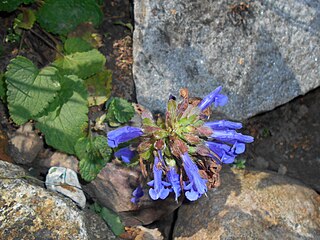
Dracocephalum rupestre is a plant species in the genus Dracocephalum, endemic to China. The specific epithet, "rupestre", is derived from Latin, and pertains to the plant growing among rocks.

Nepetoideae is a subfamily of plants in the family Lamiaceae.
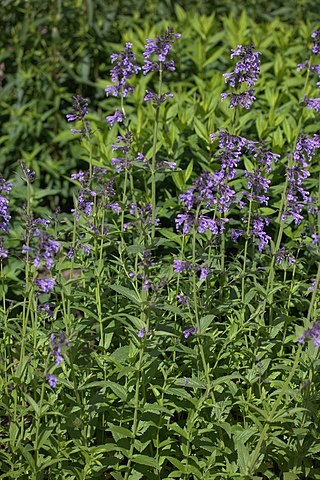
Nepeta sibirica, the Siberian catmint, is a species of flowering plant in the mint family Lamiaceae, native to Siberia.
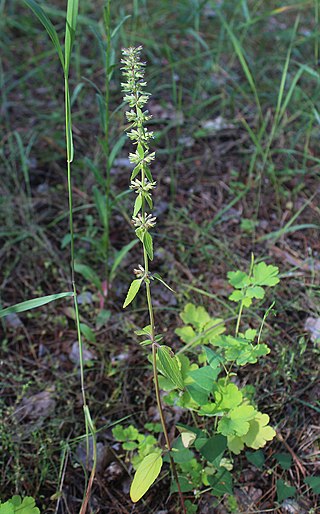
Dracocephalum thymiflorum is a species of flowering plant belonging to the family Lamiaceae.




















